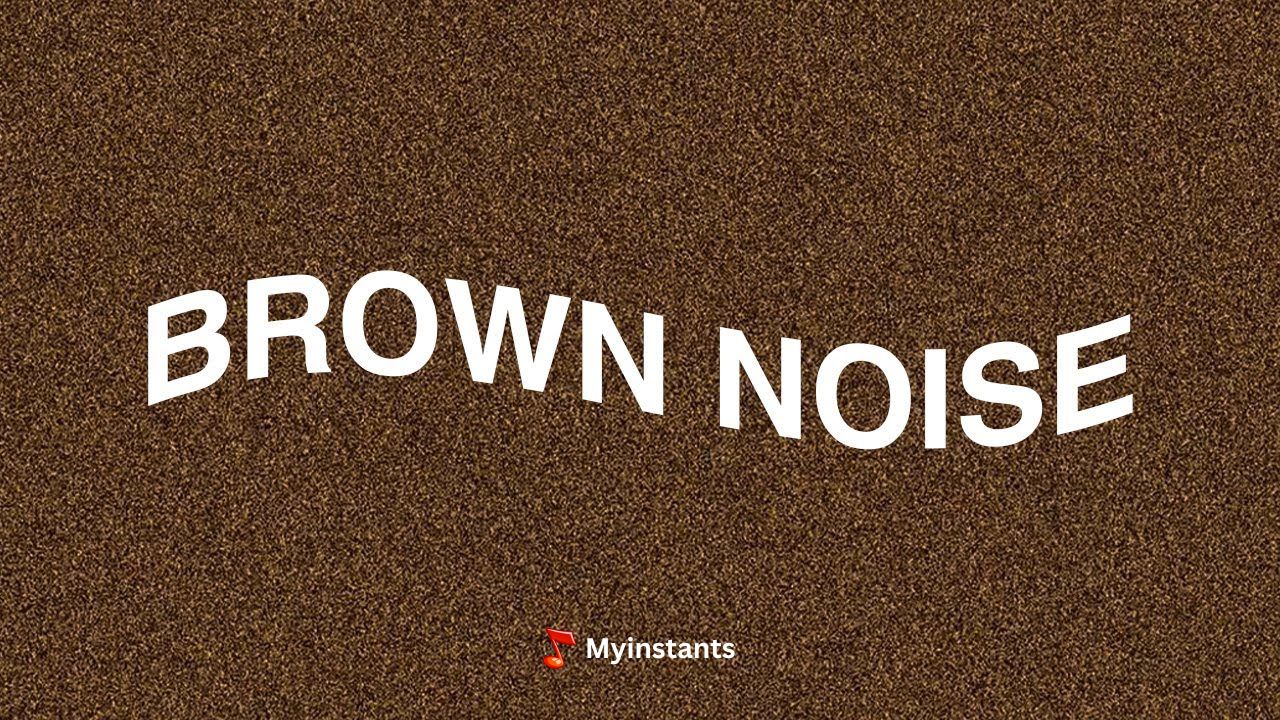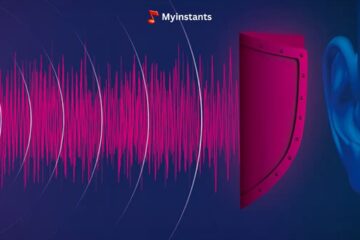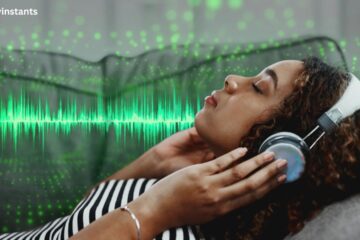In today’s world, where noise pollution is a common issue, many people seek ways to boost their productivity and improve their sleep quality. One increasingly popular solution is using different color noises, such as brown noise.
But what is brown noise, and what makes it so popular among sound enthusiasts?
In this article, we will delve into the details of brown noise, offering insights into integrating it into your daily routine to enhance your well-being.
What is Brown Noise?
You have probably heard about white noise, but what is brown noise? In this section, we will try to explain the meaning of brown noise.
Brown noise sleep, also known as Brownian noise or red noise, is a distinctive sound characterized by its deep, low-frequency rumble. It is different from white noise and rich in low-frequency components, giving it a more profound and organic quality.
Brown noise is named after a Scottish botanist, Robert Brown, who found a type of random microscopic movement called Brownian motion.
Chances are you have heard the brown noise without knowing its name. The deep sound of a waterfall, heavy rain, or thunder resembles brown noise, and many people find it calming and comforting. People also use brown noise machine to produce these sounds to improve their sleep quality.
It will help if you continue reading this post to learn more about brown noise for sleep and its benefits.
How is Brown Noise Created?
Do you know how deep brown noise is made? Albert Einstein figured it out by understanding Brownian motion. He saw that the movement of tiny particles happened due to countless random bumps. When you gather all those random bumps together, you get Brownian motion.
What’s brown noise? Similarly, brown noise is formed by adding up white noise. White noise is a random sound that’s equally strong across all pitches. When you combine it, the resulting noise weakens as the frequency increases, especially favoring low sounds.
Brown noise is a bit like pink noise, which weakens in power relative to the pitch but with more emphasis on low sounds.
What does brown noise sound like? Red light has more low-frequency waves than white light, but brown noise has a more low-pitched sound than white noise. When you listen, brown noise sounds like a deeper, bass-heavy version of white noise.
Now that you know the definition of brown noise and how it’s made, let’s move on to other details about this unique sound.
Also see: White Noise Sound Frequency, Benefits & How To Use
Brown Noise Examples
Brown or hatch brown noise has a richer, deeper tone than white noise. It favors low frequencies while minimizing high-pitched hissing.
Brown noise emphasizes low-frequency sounds while toning down the high frequencies, resulting in a smoother and more soothing sound for many. Some brown noise examples are:
- Thunder
- Rainfall
- Vacuum cleaner in action
- Fan noise
- Running stream
- Waterfall
- The sound of wind rustling through leaves
- Shower with solid water pressure
Difference Between Brown And White Noise
Now that we have covered examples of brown noise, let us understand the difference between white vs brown noise.
When explaining brown vs white noise, it is essential to mention that the two noise types differ mainly in frequency compositions. While both noises encompass all audible frequencies, white noise features an even distribution of frequencies.
When the higher frequencies are reduced in white noise, it transforms into pink noise, maintaining all audible frequencies while amplifying the lower ones. However, when you reduce the high frequencies further, it results in brown noise.
Brown noise is characterized by low-frequency components over high-frequency ones, giving it a deeper and more robust quality. This imparts a more natural sound to brown noise compared to white noise, which tends to be higher-pitched.
This explanation should clear the difference between white noise and brown noise.
Understanding The Science Behind Brown Noise
Before you start using a brown noise app to produce brown noise sound, it is essential to understand the science behind this unique sound.
What does brown noise do? Brown noise shields from external disturbances while maintaining a soothing quality, mainly because it’s more intense at lower frequencies. According to Nigg, brown noise might enhance the brain’s ability to filter out unwanted sounds, known as auditory masking. The brain could suppress unwanted noises while enhancing desired ones.
Based on studies conducted on brown noise, it is found to be helpful in the following things:
- Tinnitus
People suffering from tinnitus, or ringing in the ears, can get short-term relief using brown noise. However, more conclusive research is needed.
- Babies
Brown noise is often compared to the sounds heard in the womb, and that’s the reason it is soothing for infants.
- ADHD
According to Nigg, studies on brown noise ADHD show that brown noise is helpful for people with attention issues. It helps improve brain functions that amplify essential information, making focusing and ignoring distractions easier.
If you want to add brown noise to your daily routine to enhance your health and well-being, we suggest you use a free brown noise app. These apps offer different brown sounds to help you relax and calm your mind.
How To Listen To Brown Noise?
Now that you know what brown noise is good for, you might want to incorporate it into your daily life. This brings us to the question: where to listen to brown noise? From brown noise YouTube to brown noise machines, there are different mediums you can use. To help you out, we have provided the details below.
- Brown Noise Machines
Using brown noise machines is one of the best ways to listen to brown color sounds. You can find these machines on websites like Amazon and other retail sites. Just make sure to buy the best brown noise machine.
- Brown Noise Apps
You will find both free and paid brown noise apps. One of the most popular apps is Aura, which is known to offer high-quality brown noise tracks for mindfulness.
- Brown Noise Websites
Other than brown noise machines and apps, you can also listen to brown sounds on some websites. These sites offer noise generators that play different brown noises. You can also go to YouTube brown noise, where you will find several hour-long videos of uninterrupted brown noise. Last but not least, you can also find it on music streaming platforms.
You can try these mediums to get free brown noise and use it to enhance your well-being, boost productivity, and sleep well.
Also see: Green Noise Sound Frequency, Benefits & How To Use
How Brown Noise Helps You Focus?
Have you ever tried to focus when there’s a lot of noise around? It’s like trying to build a sandcastle on a windy beach—it’s hard to concentrate.
Luckily, scientists have discovered that certain kinds of sounds, like brown noise, white noise, and pink noise, can help you concentrate better. While not enough studies are available to explain how brown noise works, people on the internet are saying positive things about it.
Some of the sound effects of brown noise frequency include:
- Improved productivity
- Increased focus and concentration
- Enhanced problem-solving skills
- Reduced stress levels
- Increased learning capacity
Because of these benefits, brown noise has become popular among people who struggle to concentrate while working or studying. You will find a vast collection of calm brown noise online.
Can Brown Noise Help You Sleep Better?
Does brown noise help you sleep? White noise is considered a top choice when using color noises to improve sleeping habits. However, brown noise is equally helpful; many people have included it in their sleep routine.
Experts believe brown noise might be even better for sleep than white noise. This is probably because brown noise for sleeping is more calming and less disruptive than white noise. Its natural sound quality is gentler on the ears, creating a soothing sensation similar to a lullaby. Plus, brown noise contains low frequencies that help relax the body and mind, making it easier to fall asleep.
Additionally, brown noise can bring relief to those dealing with tinnitus. Many say the deeper tones of brown noise help mask their tinnitus symptoms. This claim is also backed by studies that show brown noise leads to improvements in tinnitus symptoms.
If you toss and turn on the bed, you can use brown noise to sleep. This is one of the most significant benefits of brown noise.
Benefits Of Brown Noise
Now, let’s talk about the benefits of brown noise, making it a popular choice. Listening to brown noise for anxiety has a plethora of benefits, and these include:
- Improved Sleep Quality
Many people find it hard to get good sleep for various reasons like stress or distractions. In this case, brown noise might be a great solution as it provides a calming environment that encourages relaxation and deep sleep.
Brown noises like the gentle rustle of leaves or the quiet chirping of birds can create a tranquil environment and help you fall asleep quickly. These sounds are especially helpful for people with insomnia or other sleep problems. By blocking out outside noises, brown noise makes a more peaceful sleep atmosphere, which helps your body follow its natural sleep cycle.
- Reduces Anxiety and Stress
With all the stress in one’s life, it is common for people to look for ways to handle anxiety and stay calm. One helpful solution is brown noise, which relaxes your mind and body. It reduces your stress and decreases your heart rate and blood pressure.
Studies have shown that brown noise anxiety can be especially beneficial for people grappling with anxiety disorders like panic disorder or anxiety disorder. By using brown noise, you can alleviate your stress and promote a sense of calm.
- Enhances Focus
When preparing for an exam or completing a project, it is essential to focus entirely on the task. But sometimes, you need to be more focused, reducing your productivity. If you struggle to focus on your work, brown noise can be a helpful remedy. It creates a peaceful environment and helps you to concentrate better.
Studies show that brown noise is particularly beneficial for individuals suffering from disorders like ADHD. By diminishing external stimuli, brown noise for ADHD increases focus and concentration. As a result, you can complete the task on time.
Risks Of Brown Noise
Before you start using brown noise, you will want to know is brown noise is harmful. Let’s find out the truth in this section.
Listening to brown noise continuously while sleeping can mask essential sounds like a smoke alarm or a crying baby and affect the duration or quality of your sleep. Additionally, experts warn that prolonged exposure to brown noise could lead to hearing loss, as the ears require rest too.
People who prefer listening to brown sounds at high volumes are particularly at risk of damaging their ears. A study published in BMJ Global Health in 2022 highlighted the heightened risk of hearing loss among people aged 12 to 34.
The study, which involved over 19,000 participants from 2000 to 2021, revealed that headphone use and exposure to loud venues contributed to hearing loss. The researchers estimated that 48.2% and 23.8% of hearing loss cases were attributed to loud venues and headphones, respectively. This means approx. 1.35 billion young people worldwide are at risk of hearing loss.
The researchers emphasized the need for policy action to promote safe listening practices and protect the hearing health of the population.
Is brown noise good for sleep? Although brown noise can help you sleep, you shouldn’t get too dependent on it. It is not advisable to listen to brown noise daily during sleep, which applies to kids and adults.
Should You Use Brown Noise?
What is brown noise? After learning the potential dangers of brown noise, you might wonder whether you should use it or not. Scientists are still exploring the possible health benefits of brown noise, and it may take several years to confirm these claims. In the meantime, experts suggest that there isn’t a significant risk associated with listening to brown noise as long as you adopt safe listening habits.
If you are willing to try out brown noise, you must follow these tips:
- Limit your listening sessions to 10 or 20 minutes. If you are using brown noise to improve your sleep, set a timer to allow your ears to rest once you have drifted off.
- Make sure to keep the volume at a low level so it doesn’t hurt your ears or hearing abilities.
- Avoid distractions by noise-canceling headphones, turning off other devices, and closing windows. This way, you can experience the benefits of brown noise while reducing overstimulation.
- If you have concerns about listening to brown noise or its impact on your hearing, it’s a good idea to consult your doctor.
Also see: Myinstants – Meme SoundBoard & Sound Buttons
Final Words
The benefits of brown noise extend far beyond relaxation. From improving focus and enhancing sleep quality to masking distractions and reducing stress, brown noise offers many advantages for mental and physical well-being. However, becoming dependent on brown noise is not advisable as it can cause hearing issues or discomfort. It would help to use it within a limit to get the most out of brown noise.
FAQs
What does brown noise do?
Brown noise is helpful in masking external sounds, aiding relaxation, and promoting sleep.
Which color noise is best for sleep?
The best color noise for sleep is white noise. However, many people find that brown noise to be effective as well.
Is it OK to listen to brown noise all night?
It can be safe to listen to brown noise all night, but keeping the volume reasonable is essential to avoid damaging your hearing. However, it would help if you didn’t make it a habit, as prolonged exposure to brown noise may disrupt sleep patterns or even cause discomfort.
Is brown noise the same as dark noise?
No, brown noise and dark noise are not the same. Brown noise refers to a sound with equal energy per octave, while dark noise refers to a physics or signal processing concept.
Which is better, brown or pink noise?
Whether brown or pink noise is better depends on individual preferences and needs. Brown noise has a more profound, rumbling quality, while pink noise has a softer, more balanced sound. Some people may find brown noise more soothing for relaxation or sleep, while others may prefer the gentler qualities of pink noise.
For more such interesting content, keep reading Myinstants Blog.



